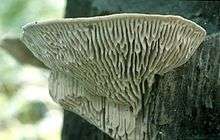Daedalea quercina
Daedalea quercina is a species of mushroom in the Polyporales order. It is the type species of the genus Daedalea. Commonly known as the oak mazegill or maze-gill fungus, the specific epithet refers to the oak genus Quercus, upon which it frequently grows, causing a brown rot. It is found in Europe, Asia, Northern Africa and Australasia. Though inedible, it can be used as a natural comb and has been the subject of chemical research.
Description



The sessile, fan-shaped fruiting bodies are typically 3–20 centimetres (1.2–7.9 in) in diameter and up to 8 centimetres (3.1 in) thick. They are found singly or in tiered groups, usually on rotting oak. The upper surface of the cap may be various shades of brown, and is sometimes zonate. The pore surface, white to tan in color, is initially porous, but as the fruit body matures, some of the pore walls break down, forming slits with blunt partitions. This results in the characteristic maze-like (daedaloid or labyrinthinine/labyrinthiform) appearance. The tube walls are 10–30 mm long, with thick walls. The basidiospores are 5–7 × 2–4 µm, smooth, and elliptical in shape. In deposit the spores are white.
This mushroom is inedible due to its cork-like texture.
A variant has been described that has large, angular pores similar to those in the genus Trametes, named D. quercina forma trametea.[1]
Habitat and distribution
Although D. quercina prefers to grow on Quercus species, it has also been found on the tree species Fagus grandifola, Fraxina americana, Juglans nigra, and Ulmus americana.[2]
It has been reported from nearly all European countries, following the pattern of oak distribution. It has also been reported in Northern Africa (Tunisia), Asia from Caucasus to India, and also Australia.[3]
Uses
Fruit bodies of D. quercina have been used as a natural comb, employed for brushing down horses with tender skin.[4] Gilbertson notes that in England, smoldering fruit bodies were used for anesthetizing bees.[5]
This species has been investigated for application in bioremediation.[6] The lignin-degrading enzyme laccase, isolated and purified from D. quercina, has shown use in biodegrading a variety of toxic dyes and pigments.[7]
The compound quercinol (a chromene derivative), isolated from the oak mazegill, has anti-inflammatory activity, and inhibits the enzymes cyclooxygenase 2, xanthine oxidase, and horseradish peroxidase.[8]
References
- ↑ Schanzle RW. (1973). "Daedalea quercina forma trametea in Illinois." Mycologia 65(3): 689–690.
- ↑ Overholts LO. (1939). "Geographical distribution of some American polyporaceae." Mycologia 13(6): 629–652.
- ↑ Kotlaba F. (1984). Zeměpisné rozšiřeni a ekologie chorošů (Polyporales s. l.) v Československu [The range and ecology of Polyporales species in Czechoslovakia Republik]. Věd. Česk.Akad. Praha.
- ↑ Rolfe F. (1974). The Romance of the Fungus World: an Account of Fungus Life in its Numerous Guises, both Real and Legendary. New York: Dover Publications. ISBN 0-486-23105-4. p. 158.
- ↑ Gilbertson RL. (1980). "Wood-rotting fungi of North America."Mycologia 72(1): 1–49.
- ↑ Asgher M; Bhatti HN; Ashraf M; Legge RL (November 2008). "Recent developments in biodegradation of industrial pollutants by white rot fungi and their enzyme system". Biodegradation. 19 (6): 771–83. doi:10.1007/s10532-008-9185-3. PMID 18373237.
- ↑ Baldrian P. (February 2004). "Purification and characterization of laccase from the white-rot fungus Daedalea quercina and decolorization of synthetic dyes by the enzyme". Appl. Microbiol. Biotechnol. 63 (5): 560–3. doi:10.1007/s00253-003-1434-0. PMID 14504838.
- ↑ Gebhardt P; Dornberger K; Gollmick FA; Gräfe U; Härtl A; Görls H; Schlegel B; Hertweck C. (May 2007). "Quercinol, an anti-inflammatory chromene from the wood-rotting fungus Daedalea quercina (Oak Mazegill)". Bioorg. Med. Chem. Lett. 17 (9): 2558–60. doi:10.1016/j.bmcl.2007.02.008. PMID 17346963.
